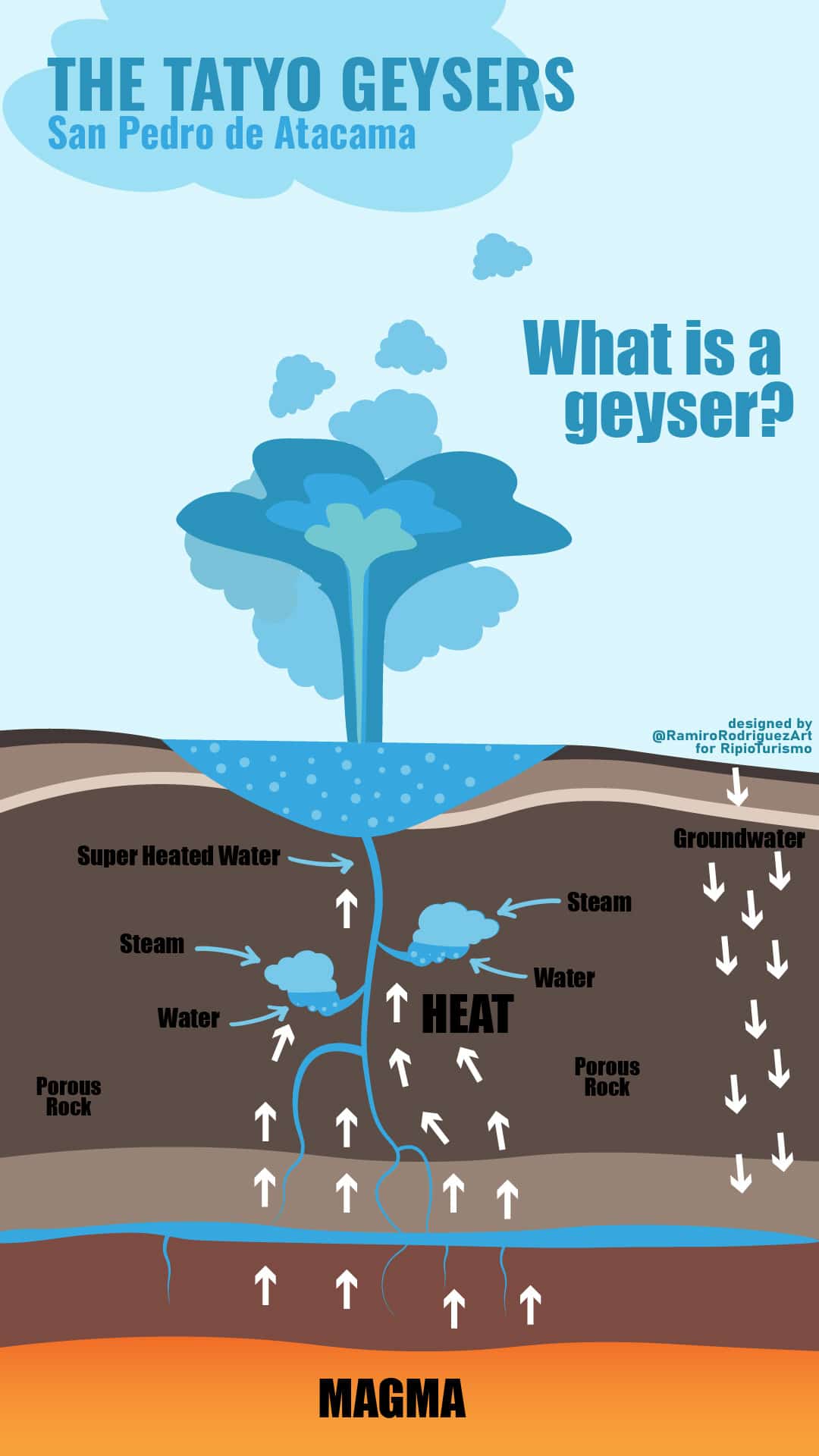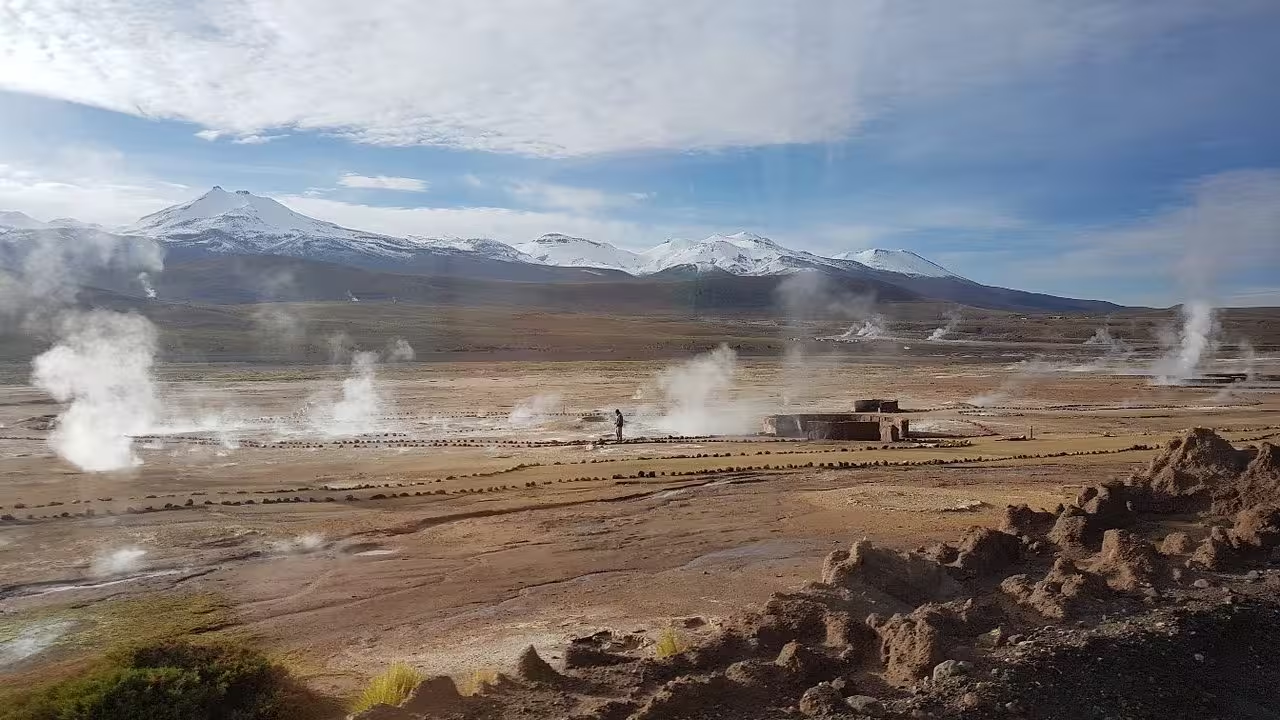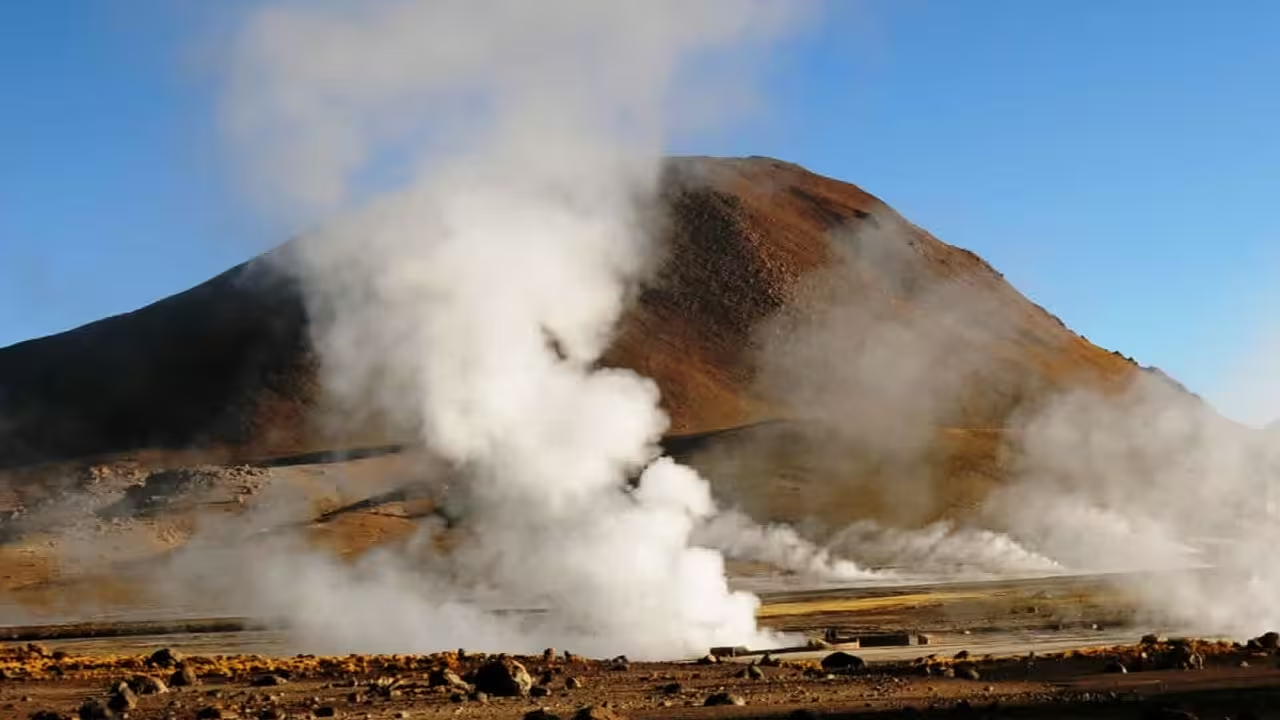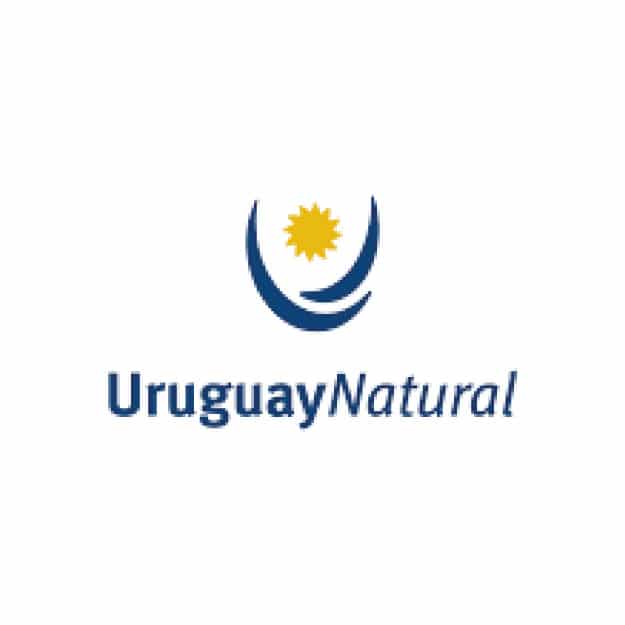The Amazing Tatio Geysers in the Atacama Desert
The Tatio Geysers are the highest geothermal field in the world. Here, steam and hot water burst powerfully from the ground.
They are located at more than 4,000 meters above sea level, making them the highest geysers on Earth. Tatio is also the largest geyser field in the Southern Hemisphere and the third largest in the world, after Yellowstone (USA) and Kronotski Nature Reserve (Russia).
Where Are the Tatio Geysers?
The Tatio Geysers are located 90 kilometers from San Pedro de Atacama.
The best time to visit is between 5:30 AM and 7:00 AM, when the steam jets can reach up to 10 meters high.
Morning temperatures are very cold, often dropping to -20°C.
On your way back, you can also visit:
-
Puritama Hot Springs, natural warm water pools
-
Machuca, a small village with just 20 houses and a church, where families raise llamas and sell handicrafts

A Bit of Geology
The geothermal field includes around 100 hot springs:
-
80 active geysers
-
About 30 springs with continuous eruption
The average height of the eruptions is:
-
69 cm for springs
-
76 cm for geysers
Tatio’s geysers represent 8% of the world’s total.
The field covers 10 km² at 4,290 meters above sea level, making it:
-
The highest geothermal field in the world
-
The largest in South America
-
The third largest worldwide
Geologically, the geysers sit in a rift valley (Tatio Valley), flanked by:
-
The Serranía Tucle-Loma Lucero on the east
-
The El Tatio Volcanic Group on the west
The underground system allows hot water to rise due to fractures in the rocks.
The water feeding the geysers comes from the southeast and travels through three aquifers:
-
Puripica
-
Salado
-
Tucle Dacite
These waters are heated by the Pastos Grandes and Guacha calderas.

The Most Important Geysers in the World
Geysers are rare because they require a mix of heat, water, and underground pipes.
The most famous geysers include:
-
Yellowstone National Park, USA
-
Dolina Geiserov, Russia
-
El Tatio, Chile
-
Taupo Volcanic Zone, New Zealand
-
Iceland
-
The Amphitheater, Las Máquinas, and Las Maquinitas, Argentina
-
Morning Sun, Bolivia
El Tatio is one of the most important geysers in the world, and a must-see if you’re visiting the Atacama Desert.

When to Visit the Tatio Geysers
It’s best to visit early in the morning, when the boiling water jets reach their maximum height of about 10 meters.
Remember, the geysers are located at over 4,000 meters, so bring warm clothes.
The Geyser Areas
There are three main areas in the Tatio geothermal field:
1. The Main Terrace
-
Located near the valley slope
-
Covers around 5 km²
-
Features large sinter terraces
-
Home to the largest geyser cones, both active and inactive
-
Geysers here can reach up to 5 meters in height
2. The Middle Terrace
-
Found just south of the Main Terrace
-
Rich in silica deposits
-
Contains deep pools (up to 3 meters)
-
Eruptions are continuous but erratic in height and timing
3. The Lower Terrace (“Grupo del Río”)
-
Located 2 km downriver from Cuenca Media
-
Close to Río Salado
-
Less silica present
-
Around 10 springs erupt near the river, with heights between 1 to 3 meters

Flora and Fauna of the Tatio Geysers
The area lies in the High Andean Steppe, between 3,000 and 5,000 meters above sea level.
It is extremely dry and has a short growing season. The Altiplanic Winter, in January and February, brings tropical rains to the area.
Vegetation near San Pedro de Atacama includes:
-
Pre-Puneña Arbusive Steppe (with isolated shrubs)
-
Yellow Straw (a clump-forming grass)
-
Coirón
-
Cacti like Kume and Chuchampe
-
Other plants like Puskayo, Oreganillo, and Pingo Pingo
Wildlife in the area includes:
Mammals:
-
Vizcachas (rodents similar to rabbits, endangered)
-
Vicuñas (wild camelids, smaller than llamas, endangered)
-
Culpeo foxes (only local carnivore)
Birds (approx. 30 species):
-
Chilean Flamingo
-
Andean Flamingo (Parina Grande)
-
James’s Flamingo (Parina Chica)
-
Piuquén (Andean Goose)
-
Juarjual Duck
-
Puna Teal
-
Baird’s Sandpiper
-
Giant Coot
-
Puna Partridge
-
Lesser Rhea (Ñandú)
-
Mountain Caracara
-
Andean Condor
-
Andean Gull (black head, white body)
-
Northern Cometocino (gray and yellow)
Important: Do not feed any wildlife.
Reptiles and Amphibians:
-
Barbara Lizard (brown with stripes, lives in bushes)
-
Andean Lizard (greenish, thick body)
-
Prickly Toad (invisible thorns felt on skin contact)
-
Vilama Frog and Hall Toad, found near hot springs
Book an excursion to enjoy the Tatyo Geysers from San Pedro de Atacama
If you’re visiting the area of San Pedro de Atacama, you can book the excursion to the Tatyo Geysers!
Visiting Atacama? check our best tours to visit San Pedro de Atacama
#353 – Santiago, Atacama Desert & Easter Island – 9 nights 
#351 – Santiago, Torres del Paine and Atacama Desert – 9 nights 
#363 – Santiago, Atacama, Torres del Paine & Skorpios III Cruise – 12 nts 
#360 – Chilean Patagonia and Atacama Desert – 12 nts 
Atacama Tours with Argentina, Peru, and other destinations in Chile
A good idea is to combine San Pedro de Atacama with other destinations in Chile, Argentina or Peru. Check some great options below:
#1052 – From Rio to Santiago via Iguazu, Buenos Aires and Atacama – 18 nts 
#1081 – Colorful Argentina, Chile & Peru – 17 nights 
#1004 – Argentina & Chile in 12 nights – Option IV – 12 nts 
#1090 – The Great tour of South America – 26 nights 
More tours to visit Chile
Want to visit Chile? Check our complete list of tours.
For more information, just contact us at info@ripioturismo.com
Thank you!














